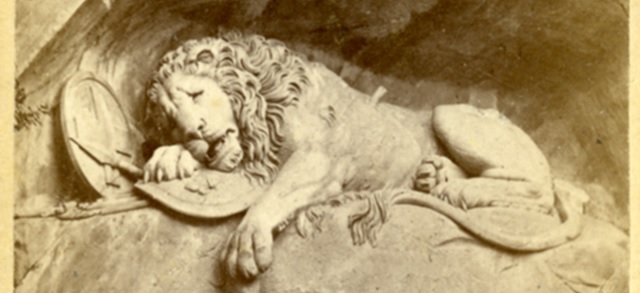
Monuments Class Projects
Architect/Sculptor of Monument
Thomas Worthington (1826-1909) & Matthew Noble (1817-1876)
Preview

Identifier
23a
Medium
photograph, carte-de-viste
Keywords
Prince Albert, Gothic Revival, Manchester, Thomas Worthington, Matthew Noble, Gothic Revival
Physical Dimensions
2.5 x 4"
Date of Publication
c.1865-1900
Name of Monument
Albert Memorial
Date of Creation of Monument
1865
City of Monument
Manchester
Location within City
Albert Square
State/Province of Monument
Greater Manchester
Country of Monument
England
Description
A carte-de-visite of the Albert Memorial in Manchester, England. The Albert Memorial stands in Albert Square, and was unveiled in 1865. Its statue is by sculptor Matthew Noble (1817-1876). while architect Thomas Worthington (1826-1909) designed the canopy, or ciborium. The Gothic Revival memorial is adorned medallions of European cultural icons, roundels depicted with star motifs, and an octagonal spire. The statue depicts the young prince in a heroic stance. Over the years, there have been proposals to demolish and replace the memorial, but these have been defeated. In 1976, the memorial was restored to its original glory.
School of Art/Architecture
Gothic Revival
Publisher
Unknown
Digital Date
2-7-2025
Copyright
Physical copy of the carte-de-visite is in the public domain. Digital copy scanned by Rod library ©2025 Rod Library, University of Northern Iowa
Creative Commons License

This work is licensed under a Creative Commons Attribution-NonCommercial 4.0 International License
File Format
image/jpeg



Comments
Manchester's Albert Memorial was unveiled in 1865 to commemorate the death of Prince Albert (1819-1861), who was the husband and prince consort of Queen Victoria (1837-1901). Prince Albert died at 42 of typhoid fever. His sudden death had a grievous impact on Queen Victoria, who mourned him for the following forty years. Victoria and Albert had a very close relationship during their marriage, and after his passing, the Queen wore black for the remainder of her life, preserved Albert’s rooms as they had been when he was alive, and encouraged the erection of numerous statues and memorials in his memory. Other notable memorials include the Albert Memorial in Kensington Gardens, London, and the Albert Clocks in Barnstaple and Belfast.
This Albert Memorial stands in front of the Town Hall in Manchester’s Albert Square. It consists of two parts, a temple encompassing the statue of Prince Albert on a pedestal in its center. The nine-foot-tall marble statue was sculpted by Matthew Noble (1817-1876). Noble was selected to create the statue as he had donated a marble bust of the prince to the city in 1857. The statue depicts the young prince wearing a military uniform and an officer’s coat in a stance similar to the one made famous by Napoleon. The statue stands atop a Roman-style pedestal on which the prince’s name is engraved.
The Gothic ciborium containing the statue was created by architect Thomas Worthington (1826-1909), who was given the assignment of creating a canopy for the statue. Worthington used a Gothic Revival design reminiscent of medieval market crosses. The memorial includes pointed arches and intensely decorated surfaces. Reliefs on the memorial include medallions with the faces of Raphael, Michaelangelo, Wren, Inigo Jones, Beethoven, Mendelssohn, Goethe, Schiller, Milton, Shakespeare, Tasso, and Dante. These cultural icons depict the arts that Albert had been passionate about during his life, including Sculpture, Music, and Literature. Close to the top of the canopy of the temple, four winged angels hold gilt trumpets. The steep canopy of the ciborium is another example of the Gothic Revival style, and is adorned with four roundels with star motifs near the base of the octagonal spire. The arches of the ciborium are also of Gothic styling and frame the statue of Prince Albert in the center.
The memorial's location in front of the Town Hall in Manchester was chosen to commemorate the Prince and his passions in the city’s most prominent square. In 1857, Manchester held the Art Treasures Exhibition, which exhibited some of the finest art of the period and was the largest art exhibition in the U.K. With over 16,000 pieces of art, it drew in 1.3 million visitors over the 142 days it was open. During its planning, Victoria and Albert granted their patronage to the event, which aided in the exhibition’s success. Prince Albert officially opened the exhibition. It later had a formative influence on the Victoria and Albert Museum in London.
Albert Square was created for this memorial. It had originally been proposed to build the memorial in front of Manchester’s Royal Infirmary, but it was decided that the Gothic Revival design of the memorial would not fit in well with the neoclassical infirmary. In 1864, the donated land where the memorial and square would be built was cleared, encompassing the demolition of over 100 buildings. Along with the new square and memorial, it was decided to also construct a new town hall for the city.
The Albert Memorial has been the subject of various proposals to move or demolish it. One defeated proposal was for it to be replaced with a war memorial shortly after the First World War. It managed to escape demolition several times through the support of campaigners. In 1976-77, it was restored to its original glory after it had fallen into disrepair. Robert Ernest Shapely, who had helped to restore it, was honored with a new inscription added to the base of the statue. Today, the memorial still stands in front of the Town Hall in Albert Square looking as it did when it was restored in the late 1970s.
Works Cited:
“Albert Memorial.” n.d. https://manchesterhistory.net/manchester/statues/albert.html.
“Mourning the Death of Prince Albert.” n.d. History Today. https://www.historytoday.com/archive/feature/mourning-death-prince-albert#:~:text=There%20were%20early%20rumours%20that,enthusiasm%20for%20mourning%20and%20monuments.
“The Albert Memorial, Albert Square, Manchester.” n.d. https://victorianweb.org/art/architecture/worthington/1.html.
Wikipedia contributors. 2024a. “Albert Square, Manchester.” Wikipedia. May 4, 2024. https://en.wikipedia.org/wiki/Albert_Square,_Manchester.
———. 2024b. “Albert Square, Manchester.” Wikipedia. May 4, 2024. https://en.wikipedia.org/wiki/Albert_Square,_Manchester.
———. 2024c. “Thomas Worthington (Architect).” Wikipedia. August 25, 2024. https://en.wikipedia.org/wiki/Thomas_Worthington_(architect).
———. 2024d. “Art Treasures Exhibition, Manchester 1857.” Wikipedia. November 26, 2024. https://en.wikipedia.org/wiki/Art_Treasures_Exhibition,_Manchester_1857.
———. 2025a. “Matthew Noble.” Wikipedia. February 14, 2025. https://en.wikipedia.org/wiki/Matthew_Noble.
———. 2025b. “Albert Memorial.” Wikipedia. February 18, 2025. https://en.wikipedia.org/wiki/Albert_Memorial.
“Worthington, Thomas 1826 - 1909 | AHRnet.” n.d. https://architecture.arthistoryresearch.net/architects/worthington-thomas.
Wyke, Terry, and Harry Cocks. 2004. Public Sculpture of Greater Manchester. Liverpool University Press.